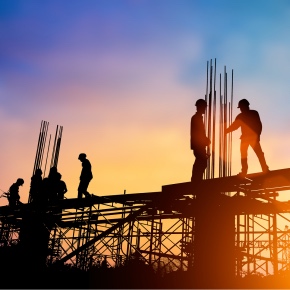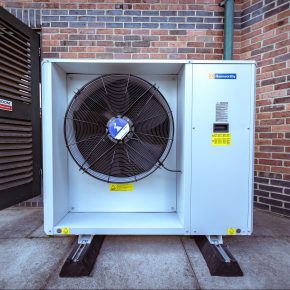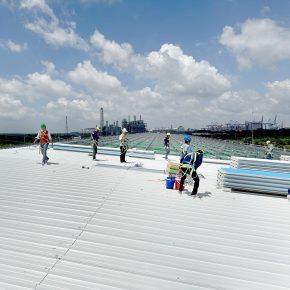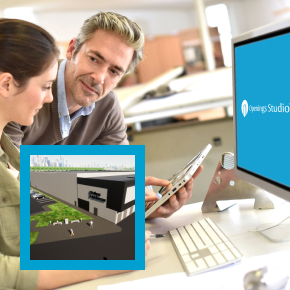
Addressing the risks of working at height
With numerous jobs in the UK construction industry requiring employees to work at height at one point or another, it’s no surprise that the industry has the reputation of holding the most dangerous jobs.
According to the HSE, falls from height are responsible for 20% of non-fatal accidents on construction sites, and in 2013-2014, 29% of fatal accidents.
With the introduction of The Work at Height Regulations 2005, further guidelines and requirements were brought in to prevent the number of injuries and deaths caused by falling from height. Any employer or person responsible for work at height within an organisation is responsible for enforcing these regulations, which, since their introduction, have resulted in an overall decline in the number of deaths in the industry.
Risks
While of course, the greatest risk of working at height is falling, there are other factors and indeed other risks associated with it. Harsh weather conditions such as rain, snow, lightening or wind speeds can affect the safety of workers performing tasks from height.
In addition, the proper setup and securing of access equipment, scaffolding or ladders is imperative. If a structure used for working at height is not properly secured or set up, the risk of falls and injuries increases exponentially.
Working at height can also pose a danger to individuals working on the ground. In many instances, tools and equipment used on access platforms, scaffolding, roofs and ladders can fall if not properly stored or secured. The items can land on employees below, resulting in head and other injuries.
Safety Tips
Proper Equipment and Maintenance:
Employees working from height rely on the structural integrity of ladders, scaffolding and access equipment for their safety. It’s important to ensure that these items are regularly inspected and maintained properly to ensure they are fit for purpose and that they are the right piece of equipment for a particular task. Railings, barriers and any safety equipment, such as harnesses, must also be inspected to ensure they are in suitable condition for the job.
Take Weather into Consideration:
While The Work at Height Regulations 2005 require that work is postponed during times of dangerous weather, it’s also important to ensure that the workplace is safe after the weather has occurred. Wet and slippery surfaces due to rain water or ice can pose a threat, as well as equipment that has been altered or damaged as a result of high wind speeds.
Worker Responsibility:
While it is the employer’s responsibility to comply with all regulations and safety precautions, they are also required to ensure that all employees are competent and able to safely undertake all tasks.
Employees also need to familiarise themselves with safe practices and requirements, and it’s vital that they undertake the relevant training courses.
Work from the Ground Where Possible:
The overwhelming consensus is that where possible, work should always be undertaken on the ground so that working at height can be avoided. Though it’s not always possible to do this, specific equipment or altering the way a task is approached can render working from height unnecessary, which will mitigate the risks.
Michael Grainger writes on behalf of UTS Sales and Repairs.
Latest news

16th April 2024
Mitsubishi Electric set to host CIBSE Journal webinar
Mitsubishi Electric will host a CIBSE Journal webinar on Wednesday 24th April 2024 at 1pm to discuss the legislation and initiatives driving changes in the way we will need to heat, cool and ventilate large commercial buildings to reach net zero emissions in the UK.
Posted in Air Conditioning, Articles, Building Industry Events, Building Industry News, Building Products & Structures, Building Regulations & Accreditations, Building Services, Facility Management & Building Services, Heating Systems, Controls and Management, Heating, Ventilation and Air Conditioning - HVAC, Information Technology, Pipes & Fittings, Plumbing, Seminars, Sustainability & Energy Efficiency, Training
16th April 2024
Hamworthy: What to consider when choosing a heat pump?
At the heart of an efficient heat pump system lies an important element: the refrigerant – Jason Allen, Commercial Product Manager, Groupe Atlantic UK, ROI & NA. Hamworthy Heating is a Groupe Atlantic brand.
Posted in Articles, Building Industry News, Building Products & Structures, Building Services, Facility Management & Building Services, Heating Systems, Controls and Management, Heating, Ventilation and Air Conditioning - HVAC, Pipes & Fittings, Plumbing, Retrofit & Renovation, Sustainability & Energy Efficiency
15th April 2024
EJOT Colorfast chosen for Kingspan’s highly sustainable new Asian factory
More than 120,000 EJOT Colorfast self-drilling fasteners have helped Kingspan to create a thermally superior, visually-appealing building envelope for its first purpose-built manufacturing plant in South East Asia.
Posted in Articles, Building Industry News, Building Products & Structures, Building Systems, Case Studies, Posts, Restoration & Refurbishment, Retrofit & Renovation, Roofs, Sustainability & Energy Efficiency
15th April 2024
ASSA ABLOY helps new manufacturing plant achieve LEED Gold certification
Improving sustainability performance is becoming a higher priority for building developers, owners and users. One consequence is fast-growing demand for green building certifications — and therefore specification. Specialist input can make the difference between hitting and missing a project target, as ASSA ABLOY explains here…
Posted in Access Control & Door Entry Systems, Architectural Ironmongery, Articles, BIM, Infrastructure & CAD Software, Building Industry News, Building Products & Structures, Building Regulations & Accreditations, Building Services, Case Studies, Doors, Facility Management & Building Services, Information Technology, Retrofit & Renovation, Security and Fire Protection, Sustainability & Energy Efficiency
 Sign up:
Sign up: